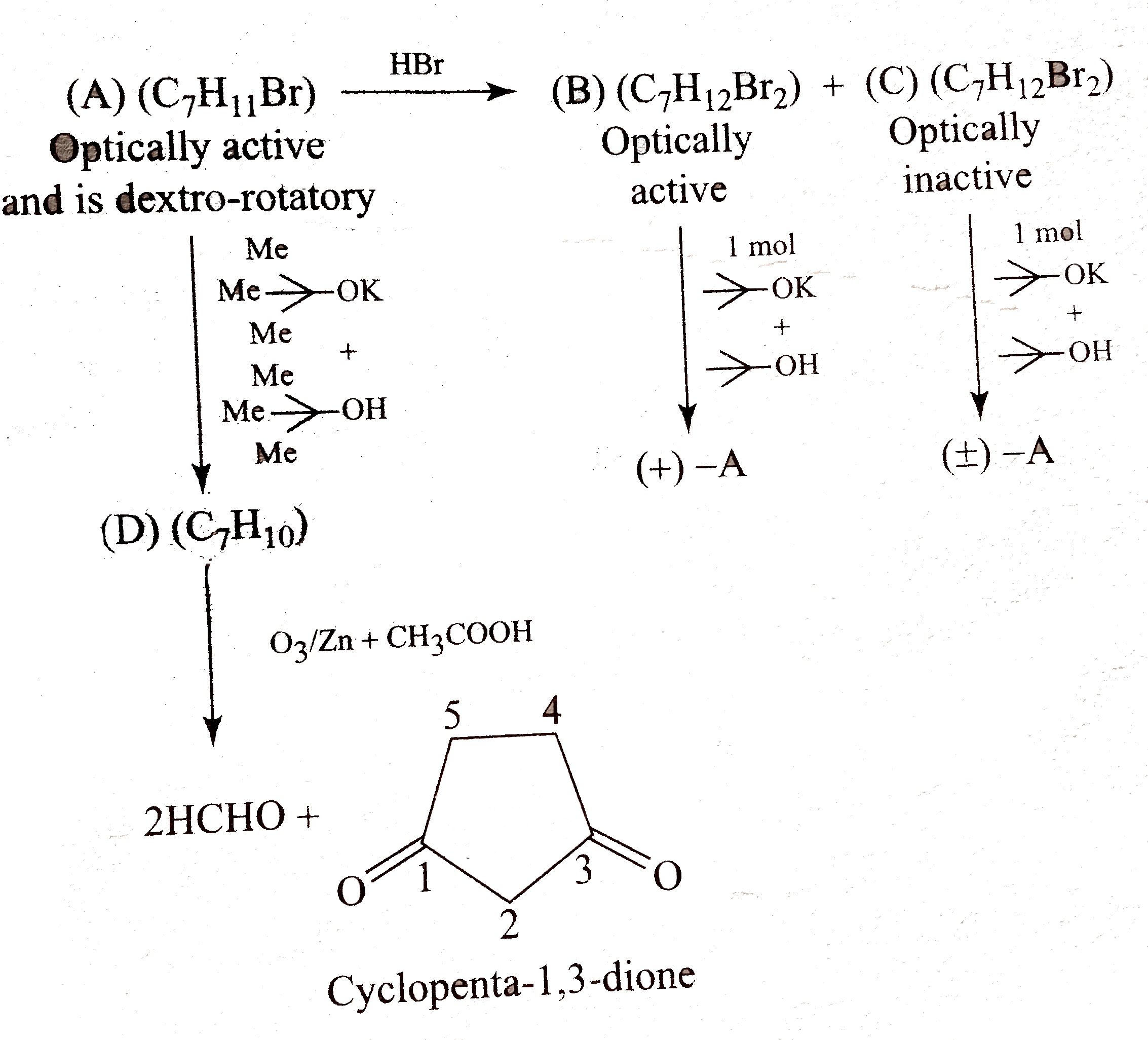The alkyl halide C4H9Br(A) reacts with alcoholic KOH and gives an alkene (B) which reacts with bromine to give a dibromide (C). (C) is transformed with sodamide into a gas (D) which forms a precipitate when passed through ammoniacal silver nitrate solution. Give the structural formulae of the compounds (A), (B), (C) and (D) and explain the reactions involved.
Since (D) forms a precipitate with ammoniacal silver nitrate, it must be a terminal alkyne and must contain-C = CH group. Moreover, (D) is obtained from (C) by the action of sodamide (a dehydrohalogenating agent). Hence, (C) must be a 1,2-dibromo derivative. Compound (C) is obtained by the action of bromine on the alkene (B). Hence, (B) should be a 1-alkene and consequently (A) should be 1-bromobutane. The reactions can be written as follows.
CH3CH2CH2Br 1-bromobutane(C4H9Br)(A)+KOH(alc.)→
CH3−CH2 But-1-ene (B) −CH=CH2+KBr+H2OCH3−CH2−Br।CH−CH2Br 1,2-dibromobutane (C)
CH3−H।C।H−Br।C।H−H।C।Br−HNaNH2−−−−→−2HBrCH3−CH2−C≡CHbut -1-yne (D )
CH3−CH2−C≡CH+[Ag(NH3)2]NO3→CH3−CH2−C≡¯¯¯C+Ag+NH4NO3+NH3 silver butnide (white precipitate)
Related Playlists
- BOOK - ICSECHAPTER - ORGANIC CHEMISTRY : SOME BASIC PRINCIPLES AND TECHNIQUES EXERCISE - REVIEW EXERCISES176videos
ORGANIC CHEMISTRY : SOME BASIC PRINCIPLES AND TECHNIQUES
- BOOK - ICSECHAPTER - ORGANIC CHEMISTRY : SOME BASIC PRINCIPLES AND TECHNIQUES EXERCISE - VERY SHORT ANSWER TYPE QUESTIONS87videos
ORGANIC CHEMISTRY : SOME BASIC PRINCIPLES AND TECHNIQUES
- BOOK - ICSECHAPTER - HYDROGENEXERCISE - NCERT TEXT-BOOK EXERCISE (With Hints and Solutions)53videos
HYDROGEN
- BOOK - ICSECHAPTER - REDOX REACTIONS (OXIDATION AND REDUCTION)EXERCISE - NCERT TEXT-BOOK. EXERCISES ((With Hints and Solutions)69videos
REDOX REACTIONS (OXIDATION AND REDUCTION)
Knowledge Check
- Question 1 - Select One
Primary alkyl halide C4H9Br (X) reacts with alc. KOH to give compound (Y). (Y) reacts with HBr to give compound (Z) which is an isomer of (X). When (X) reacts with Na metal it gives compound (P). (X), (Y), (Z) and (P) are
A X Y Z PCH3−CH∣CH3−CH2BrCH3−C∣CH3=CH2CH3−Br∣C∣CH3−CH3C8P18B X Y Z PCH3CH2CH2CH2BrCH3CH=CHCH3CH3−CH∣Br−CH2CH3C5H10C X Y Z PCH3−CH∣Br−CH2CH3CH3CH=CHCH3CH3CH2CH2CH2BrC7H14D X Y Z PCH3−CH∣CH3−CH2BrCH3CH=CHCH3CH3−CH∣Br−CH2CH3C6H12
Similar Questions
Give the stereochemical forculae for (A),(B)(C), and (D) and also give the reactions involved.
 View Solution
View SolutionPrimary alkyl halide C4H9Br :
(a) reacted with alcoholic KOH to give compound (b) is reacted with HBr to give : (c) which is an isomer of (a). When (a) is reacted with Na metal, it gives a compound (d), C8H18 hich is different from the compound formed when n-butyl bromide is reacted with Na metal. Give the structural formula of (a) and write the equations for all the reactions.View SolutionPrimary alkyl halide C4H9Br :
(a) reacted with alcoholic KOH to give compound (b) is reacted with HBr to give : (c) which is an isomer of (a). When (a) is reacted with Na metal, it gives a compound (d), C8H18 hich is different from the compound formed when n-butyl bromide is reacted with Na metal. Give the structural formula of (a) and write the equations for all the reactions.View SolutionPrimary alkyl halide C4H9Br :
(a) reacted with alcoholic KOH to give compound (b) is reacted with HBr to give : (c) which is an isomer of (a). When (a) is reacted with Na metal, it gives a compound (d), C8H18 hich is different from the compound formed when n-butyl bromide is reacted with Na metal. Give the structural formula of (a) and write the equations for all the reactions.View SolutionAn alkyl halide C5H11 (A) reacts with ethanolic KOH to give an alkene 'B' which reacts with Br2 to give a compound 'C' which on dehydromination gives an alkyne 'D' . On treatment with sodium metal in liquid ammonia one mole of 'D' give one mole of the sodium salt of 'D' and half a mole of hydrogen gas . Complete hydrogenation of 'D' yields a straight chain alkane. Identify A, B, C and D . Give the the reactions involved.
View SolutionWith alcoholic potash, C4H8Cl2 (A) gives C4H6 (B), which reacts with ammoniacal cuprous chloride. Identify the compounds (A) and (B).
View SolutionA hydrocarbon 'A' (C4H8) on reaction HCl gives a compound 'B', (C4H9Cl) which on reaction with 1 mol of NH3 gives compounds 'C' (C4H11N). On reacting with NaNO2 and HCl followed by treatment with water compound 'C' yields an optically active alcohol, 'D'. Ozonolysis of 'A' given 2mols of acetyldehyde. Identify compound 'A' to 'D'. Explain the reaction involved.
View SolutionA hydrocarbon 'A' (C4H8) on reaction HCl gives a compound 'B', (C4H9Cl) which on reaction with 1 mol of NH3 gives compounds 'C' (C4H11N). On reacting with NaNO2 and HCl followed by treatment with water compound 'C' yields an optically active alcohol, 'D'. Ozonolysis of 'A' given 2mols of acetyldehyde. Identify compound 'A' to 'D'. Explain the reaction involved.
View SolutionA hydrocarbon 'A' (C4H8) on reaction HCl gives a compound 'B', (C4H9Cl) which on reaction with 1 mol of NH3 gives compounds 'C' (C4H11N). On reacting with NaNO2 and HCl followed by treatment with water compound 'C' yields an optically active alcohol, 'D'. Ozonolysis of 'A' given 2mols of acetyldehyde. Identify compound 'A' to 'D'. Explain the reaction involved.
View Solution

